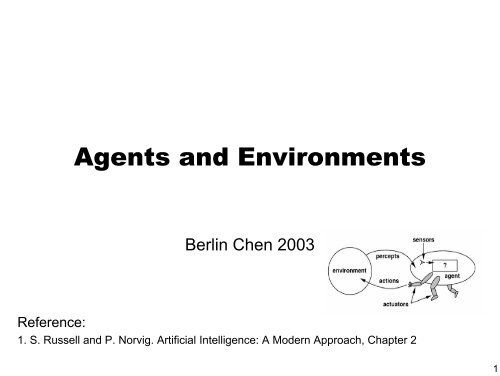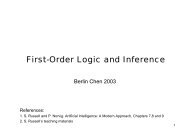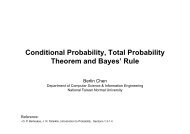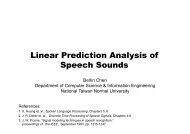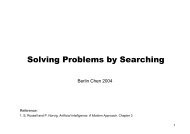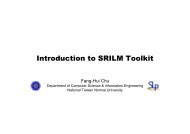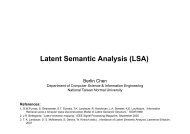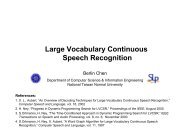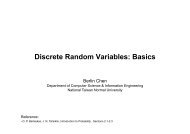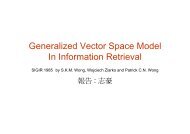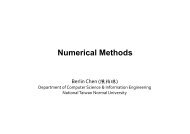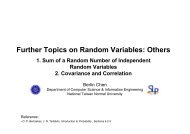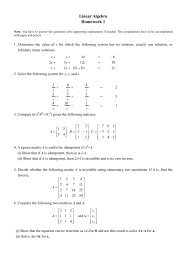You also want an ePaper? Increase the reach of your titles
YUMPU automatically turns print PDFs into web optimized ePapers that Google loves.
<strong>Agent</strong>s and Environments<strong>Berlin</strong> <strong>Chen</strong> 2003Reference:1. S. Russell and P. Norvig. Artificial Intelligence: A Modern Approach, Chapter 21
What is an <strong>Agent</strong>• An agent interacts with its environments– Perceive through sensors• Human agent: eyes, ears, nose etc.• Robotic agent: cameras, infrared range finder etc.• Soft agent: receiving keystrokes, network packages etc.– Act through actuators• Human agent: hands, legs, mouse etc.• Robotic agent: arms, wheels, motors etc.• Soft agent: display, sending network packages etc.• A rational agent is– One that does the right thing– Or one that acts so as to achieve best expectedoutcome2
<strong>Agent</strong> and EnvironmentsAssumption: every agent can perceive its own actions3
<strong>Agent</strong> and Environments• Percept (P)– The agent’s perceptual inputs at any given time• Percept sequence (P*)– The complete history of everything the agent has ever perceived• <strong>Agent</strong> function– A mapping of any given percept sequence to an action– <strong>Agent</strong> function is implemented by an agent program• <strong>Agent</strong> program( P , P ,..., P ) A*f Pn→:0 1– Run on the physical agent architecture to producef4
Example: Vacuum-Cleaner World• Percepts:– Square locations and Contents, e.g. [A, Dirty], [B. Clean]• Actions:– Right, Left, Suck or NoOp5
A Vacuum-Cleaner <strong>Agent</strong>• Tabulation of agent functions• A simple agent program6
Definition of A Rational <strong>Agent</strong>• For each possible percept sequence, a rational agentshould select an action that is expected to maximize itsperformance measure, given the evidence provided bythe percept sequence to date and whatever built-inknowledge the agent has– Performance measure– Percept sequence– Prior knowledge about the environment– Actions7
Performance Measure for Rationality• Performance measure– Embody the criterion for success of an agent’s behavior• Subjective or objective approaches– Objective measure is preferred– E.g., in the vacuum-cleaner world:amount of dirt cleaned upor the electricity consumed per time stepor average cleanliness over time(which is better?)• How and when to evaluate?A rational agentshould beautonomous!• Rationality vs. perfection (or omniscience)– Rationality => exploration, learning and autonomy8
Task Environments• When thinking about building a rational agent, we mustspecify the task environments• The PEAS description– Performance– Environment– Actuators– Sensorscorrect destinationplaces, countriestalking withpassengers9
Task Environments• Informally identified in some dimensions– Fully observable vs. partially observable– Deterministic vs. stochastic– Episodic vs. sequential– Static vs. dynamic– Discrete vs. continuous– Single agent vs. multiagent10
Task Environments11
The Structure of <strong>Agent</strong>s• How do the insides of agents work– In addition their behaviors• A general agent structure<strong>Agent</strong> = Architecture + Program• <strong>Agent</strong> program– Implement the agent function to map percepts (inputs) from thesensors to actions (outputs) of the actuators– Run on a specific architecture• <strong>Agent</strong> architecture– The computing device with physical sensors and actuators– E.g., an ordinary PC or a specialized computing device withsensors (camera, microphone, etc.) and actuators (display,speaker, wheels, legs etc.)12
The Structure of <strong>Agent</strong>s• Example: the table-driven-agent program– Take the current percept as the input– The “table” explicitly represent the agent functions that the agentprogram embodies– <strong>Agent</strong> functions depend on the entire percept sequence13
The Structure of <strong>Agent</strong>s14
The Structure of <strong>Agent</strong>s• Steps done under the agent architecture1. Sensor’s data → Program inputs (Percepts)2. Program execution3. Program output → Actuator’s actions• Kinds of agent program– Table-driven agents -> doesn’t work well!– Simple reflex agents– Model-based reflex agents– Goal-based agents– Utility-based agents15
Table-Driven <strong>Agent</strong>s• <strong>Agent</strong>s select actions based on the entire perceptsequence• Table lookup size:– P: possible percepts– T: life timeT∑ t =1Pt• Problems with table-driven agents– Memory/space requirement– Hard to learn from the experience– Time for constructing the tableHow to write an excellent programto produce rational behavior from asmall amount of code rather thanfrom a large number of table entries• Doomed to failure16
Simple Reflex <strong>Agent</strong>s• <strong>Agent</strong>s select actions based on the current percept,ignoring the rest percept history– Memoryless– Respond directly to perceptsthe current observed staterule-matching functionrule– Rectangles: internal states– Ovals: background informatione.g., If car-in-front-is-braking then initiate-braking17
Simple Reflex <strong>Agent</strong>s• Example: the vacuum agent introduced previously– It’s decision is based only on the current location and on whetherthat contains dirt– Only 4 percept possibilities/states ( instead of 4 T )[A, Clean][A, Dirty][B, Clean][B, Dirty]18
Simple Reflex <strong>Agent</strong>s• Problems with simple reflex agents– Work properly if the environment is fully observable– Couldn’t work properly in partially observable environments– Limited range of applications• Randomized vs. deterministic simple reflex agent19
Model-based Reflex <strong>Agent</strong>s• <strong>Agent</strong>s maintain internal state to track aspects of theworld that are not evident in the current state– Parts of the percept history kept to reflect some of theunobserved aspects of the current state– Updating internal state information require knowledge about• Which perceptual information is significant• How the world evolves independently• How the agent’s action affect the worldthe internal stateprevious actionsrule20
Model-based Reflex <strong>Agent</strong>s21
Goal-based <strong>Agent</strong>s• The action-decision process involves some sort of goalinformation describing situations that are desirableWhat will happenif I do so?Consideration ofthe future– Combine the goal information with the possible actions proposedby the internal state to choose actions to achieve the goal– Search and planning in AI are devoted to finding the right actionsequences to achieve the goals22
Utility-based <strong>Agent</strong>s• Goal provides a crude binary distinction between “happy”and “unhappy” sates• Utility: maximize the agents expected happiness– E.g., quicker, safer, more reliable for the taxis-driver agent• Utility functionMakeational decisions– Map a state (or a sequence of states) onto a real number todescribe to degree of happiness– Explicit utility function provides the appropriate tradeoff oruncertainties to be reached of several goals• Conflict goals (speed/safety)• Likelihood of success23
Utility-based <strong>Agent</strong>s24
Learning <strong>Agent</strong>s• Learning allows the agent to operate in initially unknownenvironments and to become more competent than itsinitial knowledge might allow– Learning algorithms– Create state-of-the-art agent!• A learning agent composes of– Learning element: making improvements– Performance element: selecting external action– Critic: determining how the performance element should bemodified according to the learning standard– Problem generator: suggesting actions that lead to new andinformative experiences if the agent is willing to explore alittle25
Learning <strong>Agent</strong>sReward/Penaltytake in perceptsdecide on actions26
Learning <strong>Agent</strong>s• For example, the taxis-driver agent makes a quick leftturn across three lines if traffic– The critic observes the shocking language from other drivers– And the learning element is able to formulate a rule saying thiswas a bad action– Then the performance element is modified by install the new rule• Besides, the problem generator might identify certainareas if behavior in need of improvement and suggestexperiments,– Such as trying out the brakes on different road surface underdifferent conditions27


